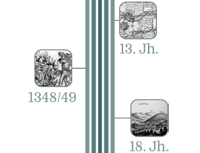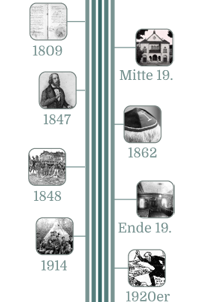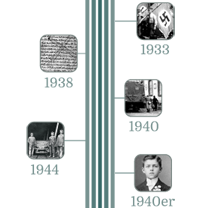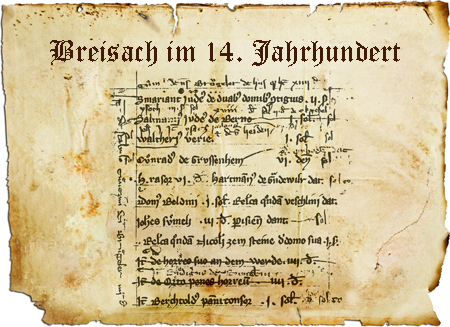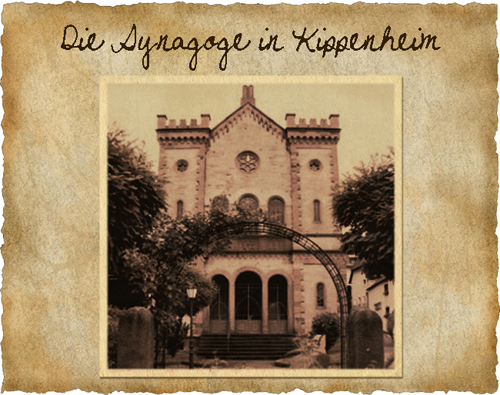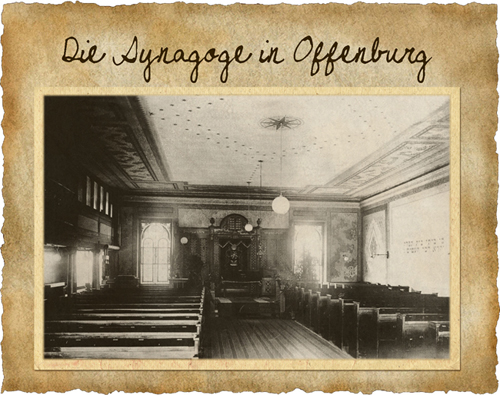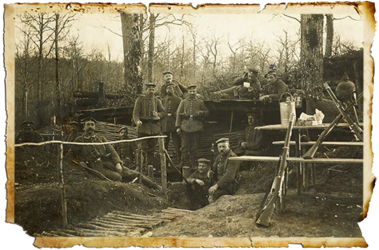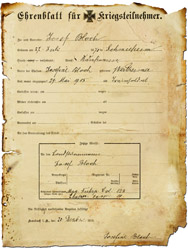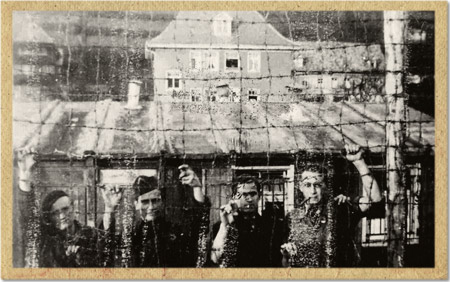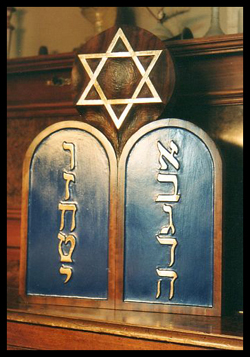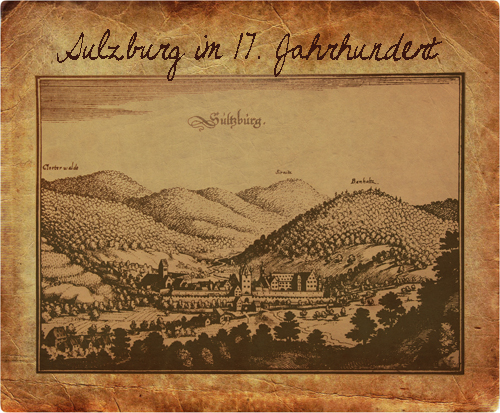
Suppression of minorities, social exclusion and racism are characterising elements of our history. It is therefore our responsibility to learn from it. After all, learning democracy means examining and analysing past and present happenings and to bear crimes against humanity in remembrance – to make sure that these aspects of our history cannot be repeated. This journey sheds light onto part of Baden history which shows us how tyranny, suppression of minorities and racism was exercised on the backs of individual persons. There are always individual fates behind the large anonymous figures of history books. The people behind the facts contribute as many small, however important little pieces of a mosaic to the overall history and bring it to life. In this text the fate of individual persons in the southern Upper Rhine region is recounted. They are an example for many further victims. The history of the Baden Jews and of forced labourers during World War II is a reminder to learn from the past.
The Beginnings
13th century – Beginnings of German Jewry
The emergence of German Jewry lies well back, Jewish communities can be traced back to very early times in the German speaking areas. However, they are exposed to many disadvantages in connection with economic and political issues as they form a minority in the Christian Europe. The oldest documentary evidence for the presence of Jews in Baden originates in the 13th century. There are numerous Jewish communities in the 14th century. The population gains great importance for the economic situation of the town by its trade, pawnshops and money lending business. As the church prohibits Christians to do this kind of business, it is largely left up to the Jews.1348/49 – Black Death pogroms in the Middle Ages
The Jews are already persecuted in the middle ages. Black Death pogroms peak in 1348/49. The Jews are accused of having poisoned the wells and thus to be responsible for the plague. In this period many Jews are burnt at the stake or lose their money by slander, open debts are not paid back. Jewish communities are destroyed in hundreds of places in Germany. These occurrences characterise a far-reaching cut in the history of German Jewry.After some years the occasional Jew returns to South Baden. In these times, however, the local landlords only permit settlement at a few places by. The most frequent reason behind granting the permission is the earnings from special taxes. The daily life of the Jews is characterised by many restrictions. As they are excluded by law from handicrafts and farming, they can do nothing but trade.
18th century – Emergence of a Jewish culture
The life of the Jews in Germany is characterised by hostility and restrictive laws. However, there are also phases in which Jews and Christians live to a large part together peacefully and in which the Jewish communities can grow.Upheaval
1809 – Baden Jews edict: An end to discrimination?
By the fairly well informed Margrave Karl Friedrich of Baden some anti-Jewish regulations are abolished at the beginning of the 19th century. This sign of tolerance also has a positive effect on the coexistence of Christians and Jews. The Baden Jews Edict of 1809 finally improves the status of the Jews by regulating their civil and canonical relationships. As from issuing this degree the Jewish religious community is state-approved and bureaucratically tightly linked to the state. As from this point Jews have an unrestricted right to stay, the abolition of the “Protection money for Jews” and the cancellation of the special levies relieve the Jewish population sustainably. Baden as a whole is relatively progressive and liberally minded in these times. However, there is no question of complete equality of the Jews as the deeply rooted antisemitism of the non-Jewish population still leads to discriminations in day-to-day life. However, the new freedom makes it possible for Jewish communities to build synagogues.Mid-19th century – Building Synagogues: Centre piece of the Jewish communities
As from the middle of the 19th century the Jewish communities can, thanks to the eased laws, build new Synagogues or extend old ones. Consequently the partly elaborately built prayer halls also represent the self-confidence of the communities at that time.1847 – Roots of our Democracy: Offenburg Assembly
[The 13 Demands of the People]
1848/49 – The Baden Revolution
With the year of Revolution 1848 the idea of a democratic state is spread, also in the lower classes. The Baden grand duke flees when 30-40,000 representatives of the Baden people’s associations collect in Offenburg on 13/14 May 1849. The Republic is proclaimed in Karlsruhe. The young republic can only withstand the grand duke and his allied armed forces for but a few weeks. The democrats are beaten at the beginning of July. While many revolutionaries emigrate, a phase of standstill sets in in Baden. Only when Grand Duke Friedrich I takes over and signals reforms in 1860 does this situation change.1862 legal equality for the Jewish population
The Jewish emancipation, a long and rocky road lasting almost 70 years in Baden, began with the époque of enlightenment in the 18th century and was finalised with the legal equality between Jews and Christians. In 1862 the liberally ruled Grand Duchy Baden grants its Jewish fellow citizens, as first German state, unrestricted equal rights. By the so-called “Baden Jew Edict” all the social, religious and legal discriminations existing to date are to be abolished. At least formally the Jewish population now enjoys an equal status even if reality is otherwise: In Baden a considerable anti-Semitic protest is stirred up. In defiance of the enmities, numerous Jews of the South West and of the entire German Reich move into the towns. Freedom, which they had been denied for a long time, paves the way for the Jewish population to new opportunities.1870 – the German Empire is founded. The long aspired national unity has been achieved, however without the desired freedom. However, progress is also found in the empire. With the enforcement of the constitutional monarchy and the imperial constitution of the German empire, the imperial act on the equal status of the citizens, no matter of what religion, is enforced, among others, in 1871. However, this does not always correspond to reality where the equal treatment of Jews in the population is concerned. Jews feel their special legal, social and economic status even under the German empire. Notwithstanding this period is characterised by the primarily peaceful cohabitation of the religious denominations. A sign of the flourishing Jewish culture and centres of the Israelite communities is found in many places in the partly magnificent Synagogues.
End of the 19th century – Period of tolerance
Despite all obstacles and animosities the legal equal status stands for unprecedented freedom and heyday for many Jewish communities. Numerous Jews are drawn to the towns. Consequently and after many years, a Jewish community also settles in Offenburg again. In other places, too at which Jews now settle prayer rooms are newly set up, which quickly become too small for the ever-increasing communities.1914 – World War I and the end of the empire
The German empire steers towards a catastrophe which becomes bitter reality on 1 August 1914: the beginning of World War I. Determined by the imperial constitution, Baden troops also march under Prussian command. Among them also many Jews who, despite suppression and discrimination over many centuries, now risk their lives in the war. The vicinity of Baden to France fuels the fear of French troops among the population. Furthermore, the poor supply situation during the war brings hunger and deprivation to the people. In November 1918, after the end of the war the suffering of the people is let out in revolutionary unrests which bring about the fall of the monarchic authoritarian state.1920ies – Failure of the young Weimar Democracy
[Childhood memories of Jewish Kippenheim - Kurt Maier recounts]
What follows the November revolution is a new period in German history: The Weimar Republic comes to be. A parliamentary democracy is experienced for the first time in Germany, which many citizens are, however opposed to. Wrong internal political decisions, the low standing of fundamental rights, the poor economic situations and the high unemployment figures in such connection and not least the authoritarian state thinking of the citizens, slowly but steadily lever the Weimar Reichsverfassung (constitution). Anti-Semitism gains impetus, using purposely aimed propaganda Jews are once again blamed for the poor conditions. Thus the military defeat is founded by the “stab-in-the-back myth” of right-wingers. According to this myth the battle against the enemy was not lost, but could be traced to the conduct of traitors in the own country. In order to fuel hatred, Jews, communists and social democrats are presented as part of a Jewish-socialist conspiracy against the world, which is perceived as a threat for the German population. The democratic structure of the young Weimar Republic is put to question by the appointment of Adolf Hitler as Reichskanzler on 30th January 1933. The way to the dictatorship of the 3rd Reich is paved.
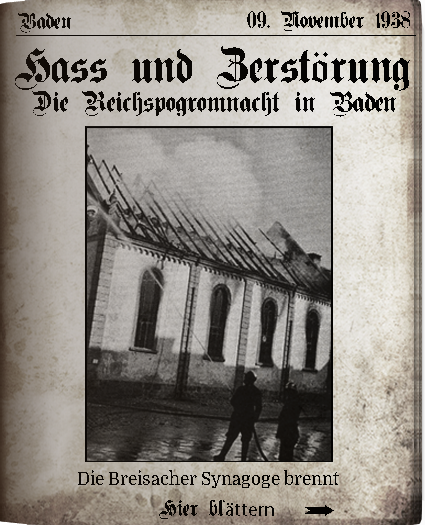
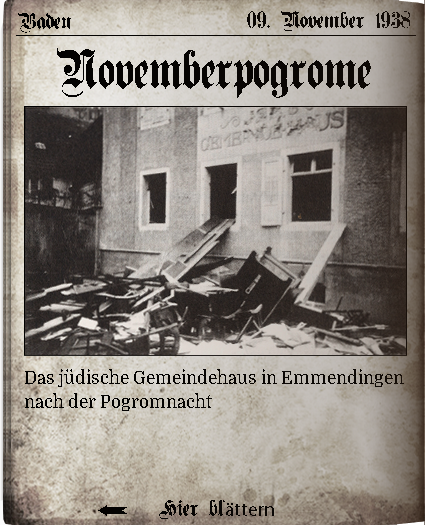
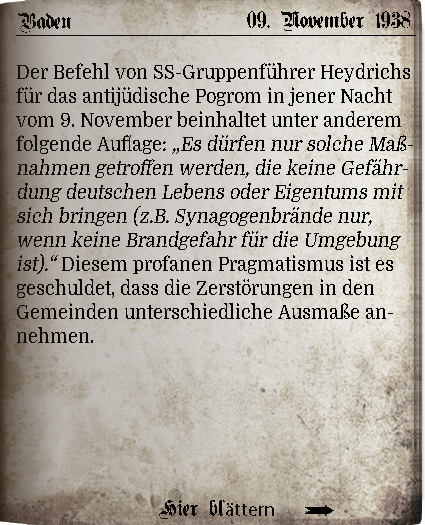
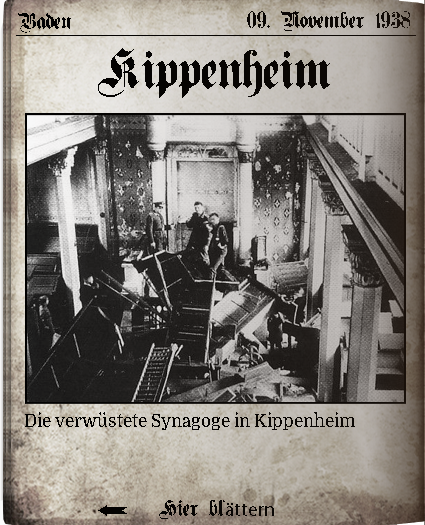
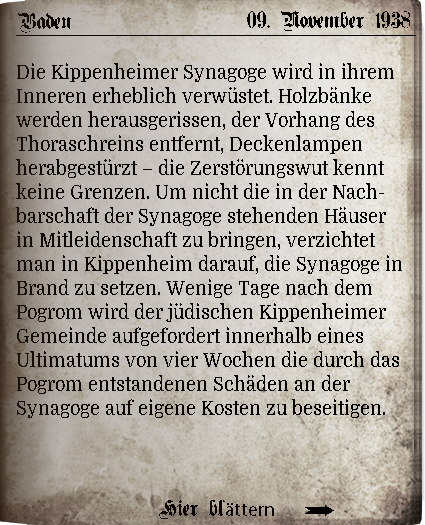
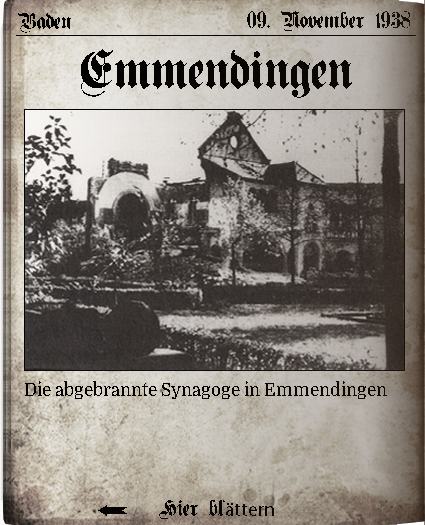
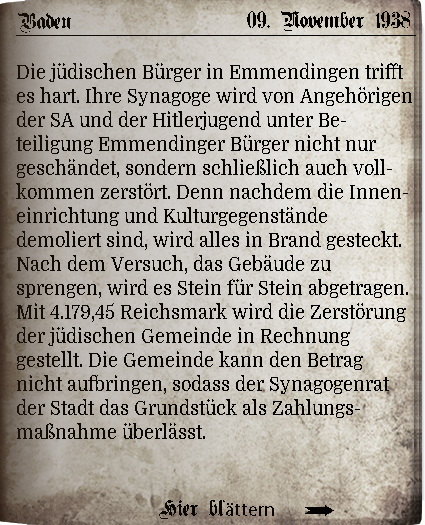
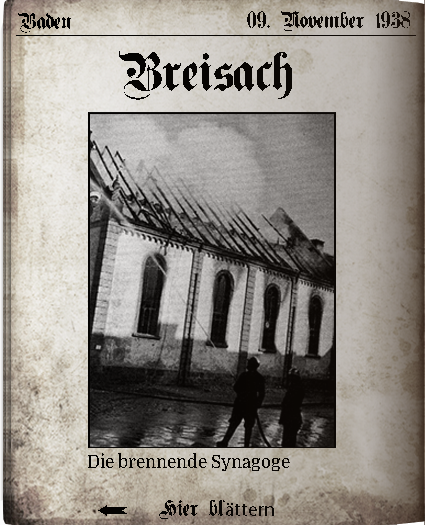
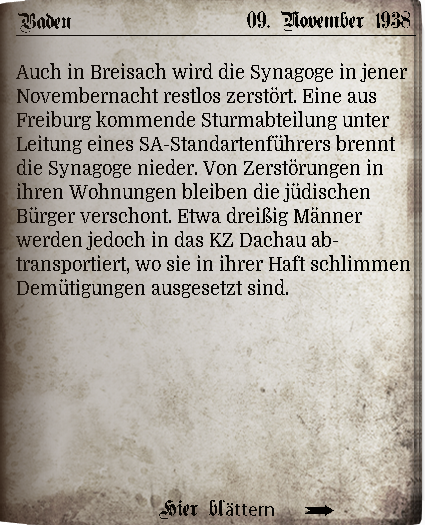
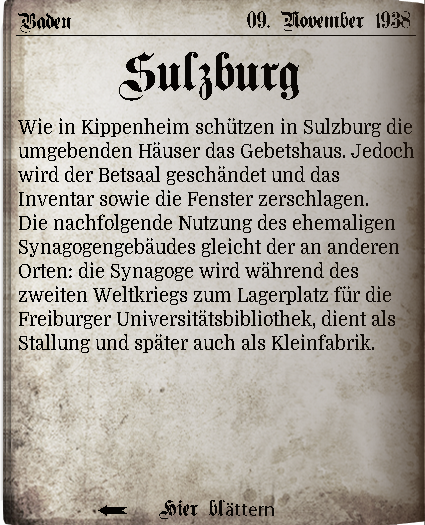
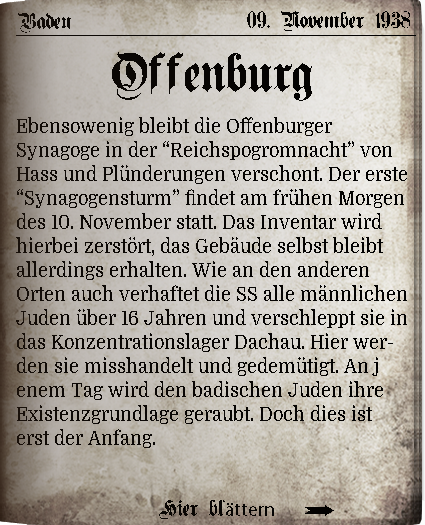
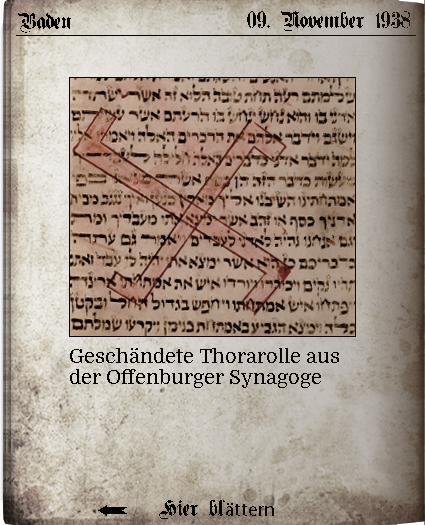
Such Jews as had not fled Germany yet, are exposed to unimaginable humiliations, harassments and dangers. The plan of the national socialists to make Germany “free of Jews” becomes bitter reality for the Baden and the Saarpfalz Jews on 22nd October 1940. It is the mass deportation to the unoccupied zone in South France known as the “Aktion Wagner-Bürckel/Operation Wagner-Bürckel” A term defining mourning, desperation and horror. In the early morning of this Tuesday, the day of the Jewish Feast of Tabernacles, gestapo officials appear on the wcen. They penetrate into the flats of Jewish citizens and issue the command that they only have little time to prepare themselves for a journey to an unknown destination. The arrested may merely take along a few personal belongings. This day means the end of many Jewish communities in Baden and the Palatinate. On that day over 6500 Jews from 132 places are robbed of their home in South West Germany and deported on the long, arduous journeys to internment camps. Notaries wait at their departure to get signatures from the captives by which they transfer all their property. In the camp Gurs, on the northern edge of the Pyrenees in South France, catastrophic conditions prevail. Many of the interned die of hunger, disease or exhaustion. Some are, however, able to assert their emigration, to flee or to bribe the guards to be set free. In January 1942 the national socialists resolve the systematic murder of the European Jews at the Wannsee Conference in Berlin. As from August 1942 the internment camps in South France are emptied; the remaining internees are transported to the camp Drancy near Paris and deported from there to the extermination camps Auschwitz-Birkenau and Majdanek where they are murdered in gas chambers. The furniture and other possessions from the houses of the deported Jewish citizens are auctioneered in public. In these times most people are glad to snatch a “bargain”. The borders between the rightful and the wrong are blurred by Hitler’s propaganda policy. Only a few seem to critically question this action. Obviously all are however sure, that their Jewish neighbours will not come back again.
The camp Gurs, at the foot of the Pyrenees, is the largest French internment camp and is governed by the French authorities. The acceptance of the Baden Jews is absolutely unexpected. The camp is totally inadequately fitted; the situation becomes catastrophic due to overcrowding. As there are not enough straw bags which serve as sleeping berth, many of the new arrivals have to spend the night on the cold floor. Upon arrival in the camp women and men are separated, couples and whole families are torn apart. The separation from their family members is particularly awful for the people in this desperate situation. Children aged up to twelve are allowed to stay with their mothers. If the children are older, they are also separated from the persons they can trust.
Not only German Jews are interned in the camp in Gurs. Jews of most different nationalities, but also French communists, pacifists and trade unionists are considered a danger to the regime and are locked away. The suppression of minorities and dissidents is expressed here in the most horrific of form.
Apart from emotional and material deprivations, the people suffer from the lack of most fundamental things such as medical care and hygiene. This makes the life of the internees even more difficult. There is not enough food. A coffee in the morning a bread ratio and a watery soup twice a day have to suffice for the internees. Due to the very poor supplies the death rate is very high. Particularly in the winter 1940 / 41 up to 15 people die a day. Thanks to the help of Jewish, Christian and non-denominational charitable organisations the conditions in Gurs improve a little in the course of 1941.
Despite internment, some few German Jews still have the opportunity to emigrate via Spain and Portugal, others are able to flee the camp with the help of charitable organisations. Roughly one third of the Baden and Palatinate Jews, who had been deported from their home on 22nd October, survives the horror of the Nazi regime by escape and emigration. Those who are less lucky are deported to the extermination camps and concentration camps Auschwitz-Birkenau and Majdanek where they are murdered.
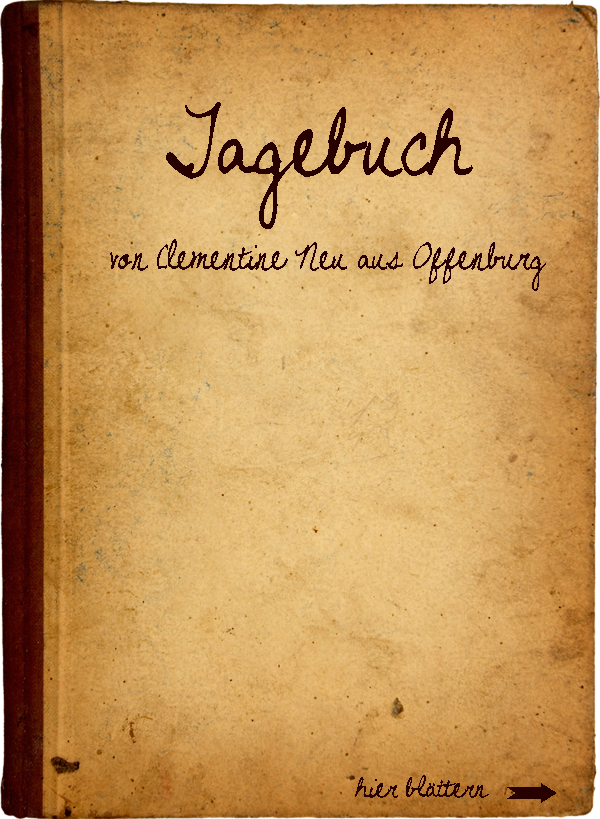
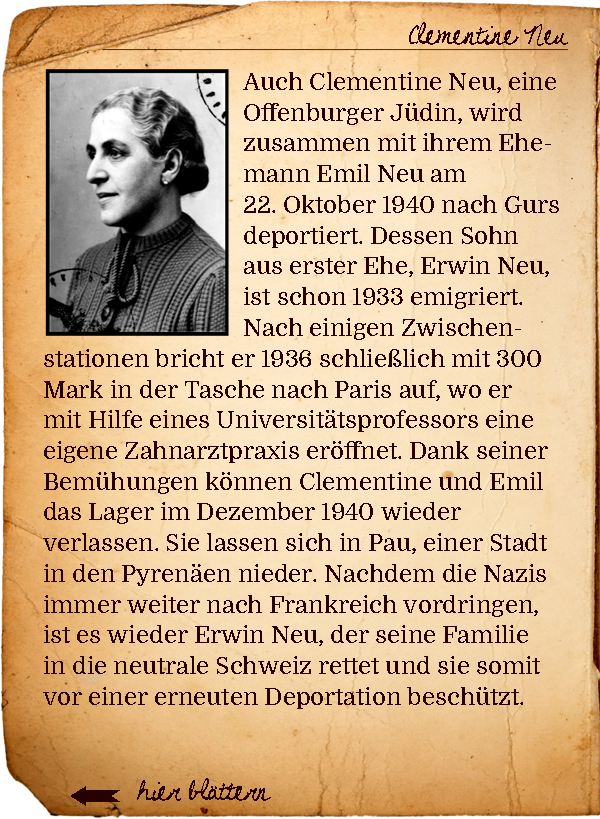
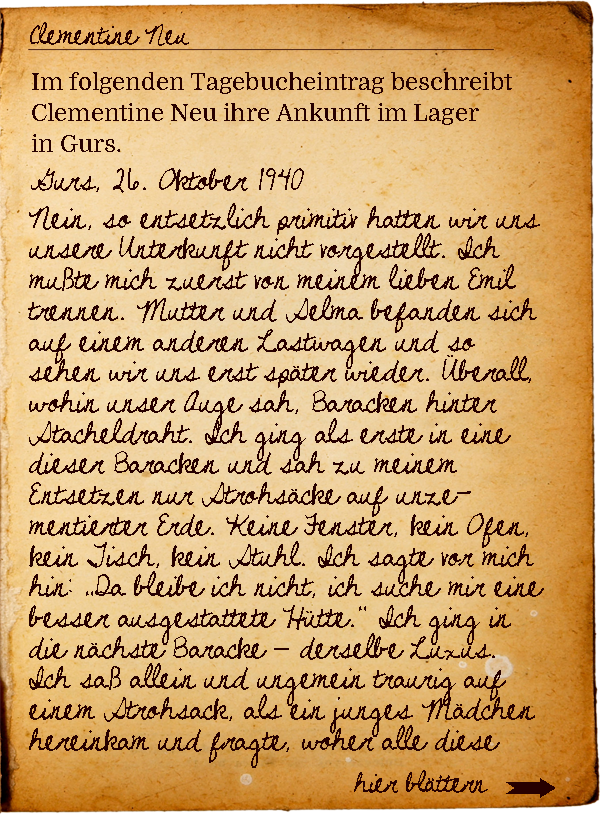
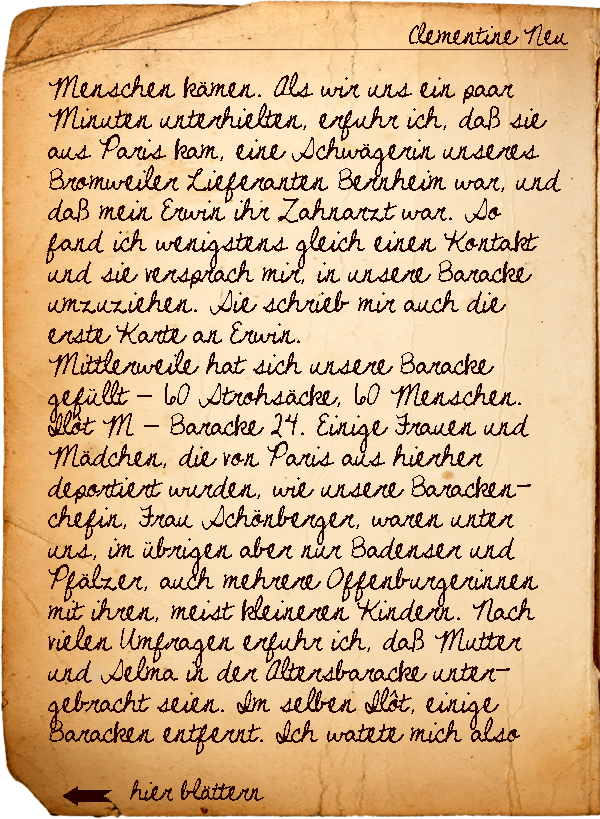
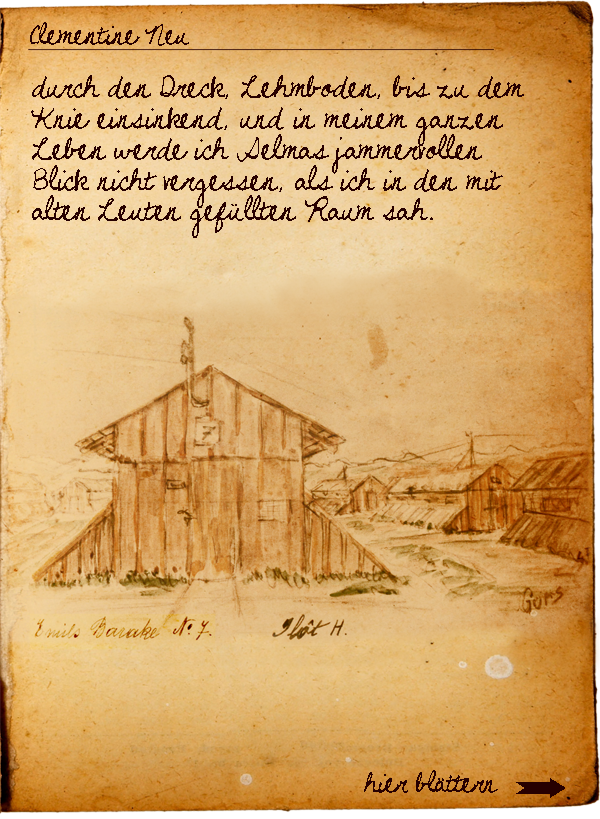
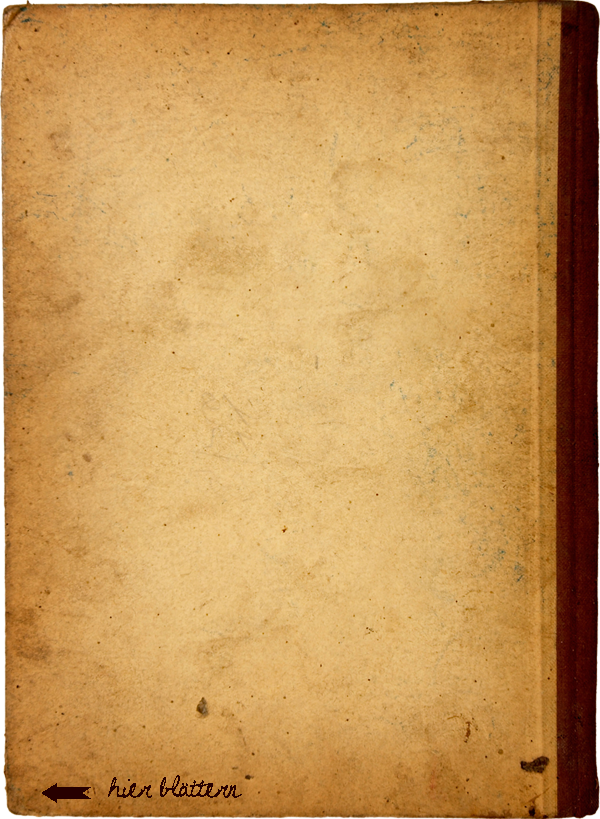
The national socialists need a great labour force for their senseless war. As the Wehrmacht already deploys the male generations as soldiers, labour in the armament industry is missing. What to do? As already many a time previously, violence is the answer of the regime here,too. By all ways and means labour forces are carted from the occupied regions. In many cases forced labour is also seen as punishment for those who put up resistance. The living conditions of the labourers are catastrophic in the camps as they are treated as “slave labourers”.
Three labour camps are set up in Haslach from 1944 to 1945. Here prisoners are forced to work under inhuman conditions. They have to build access roads to ensure that the already existing mines of the “Hartsteinwerke Vulkan” can be converted into an armament factory. As from September over 1700 prisoners arrive in Haslach, over 1200 of whom are recorded by name. They come from different countries. The major number of prisoners comes from France and Russia. The outcome of the concentration camps “Sportplatz”, of the “Höllenlager Vulkans” and of the camp “Kinzigdamm” is a sad one: Verifiably 223 men die in Haslach, they are buried in front of the cemetery wall. Some of the dead are buried in the mine itself. Hundreds die before the end of the war in camps or only survive the end of the war by a short time.
Nazi regime
1933 – The beginnings of the Nazi period
The national socialists gain ever more power in large parts of the population by the process of enforced conformity and by clever propaganda. The national socialist ideology thereby penetrates ever further into the state, economic, social and cultural sectors. One of the mainstays of the Nazi ideology is anti-Semitism. In the course of the striven at “Aryanisation” the Jews are systematically pillaged and their economic existence is destroyed. Hitler deprives the Jewish population of their livelihood. The increasing deprivation of the rights of minorities, for instance also of the Sinti and Roma, often leads to individual people defining themselves as “Aryan” and usually member of the NSDAP, the Hitler Party. Step for step anti-Semitic ideas are laid down in laws and executed by the authorities. For the Jews this once again means discrimination and persecution in Germany all the way to the murder of millions in the extermination camps in occupied Poland.1938 - Demonstrative humiliation of a culture
[Family Bloch from Haslach on the night of pogroms]
"Germans! Fight back! Don’t buy from Jews!"
With such paroles the boycott forms the public call not to buy from Jewish businesses, the beginnings of the persecution. Two years later the “Nuremberg Laws” are adopted which revoke the Jews’ civil rights. Jews are degraded to second class citizens of the Reich and no longer have any social and political rights. The fuelled hatred against the Jewish minority culminates in the November pogroms 1938 in which Synagogues, Jewish businesses, residences and cemeteries are destroyed. Following these outrageous pogroms all Jews in Baden aged 16 to 60 are deported to the concentration camp Dachau near Munich. After some weeks the men are released again, however on condition not to speak about what they experienced and to leave the country.












1940 - Deportations in Baden
On 1st September 1939 Nazi Germany unleashes World War II by the invasion of Poland. For the Jews in the communities near the borders, e.g. Breisach this means that they have to leave their houses and flats and “evacuate” themselves.Such Jews as had not fled Germany yet, are exposed to unimaginable humiliations, harassments and dangers. The plan of the national socialists to make Germany “free of Jews” becomes bitter reality for the Baden and the Saarpfalz Jews on 22nd October 1940. It is the mass deportation to the unoccupied zone in South France known as the “Aktion Wagner-Bürckel/Operation Wagner-Bürckel” A term defining mourning, desperation and horror. In the early morning of this Tuesday, the day of the Jewish Feast of Tabernacles, gestapo officials appear on the wcen. They penetrate into the flats of Jewish citizens and issue the command that they only have little time to prepare themselves for a journey to an unknown destination. The arrested may merely take along a few personal belongings. This day means the end of many Jewish communities in Baden and the Palatinate. On that day over 6500 Jews from 132 places are robbed of their home in South West Germany and deported on the long, arduous journeys to internment camps. Notaries wait at their departure to get signatures from the captives by which they transfer all their property. In the camp Gurs, on the northern edge of the Pyrenees in South France, catastrophic conditions prevail. Many of the interned die of hunger, disease or exhaustion. Some are, however, able to assert their emigration, to flee or to bribe the guards to be set free. In January 1942 the national socialists resolve the systematic murder of the European Jews at the Wannsee Conference in Berlin. As from August 1942 the internment camps in South France are emptied; the remaining internees are transported to the camp Drancy near Paris and deported from there to the extermination camps Auschwitz-Birkenau and Majdanek where they are murdered in gas chambers. The furniture and other possessions from the houses of the deported Jewish citizens are auctioneered in public. In these times most people are glad to snatch a “bargain”. The borders between the rightful and the wrong are blurred by Hitler’s propaganda policy. Only a few seem to critically question this action. Obviously all are however sure, that their Jewish neighbours will not come back again.
[How Kurt Maier experienced Deportation]
[Emma Schwarz reports on her Deportation]
1940-1943 – The Camp in Gurs
[Kurt Maier tells the story of the emigration of his family]
Not only German Jews are interned in the camp in Gurs. Jews of most different nationalities, but also French communists, pacifists and trade unionists are considered a danger to the regime and are locked away. The suppression of minorities and dissidents is expressed here in the most horrific of form.
Apart from emotional and material deprivations, the people suffer from the lack of most fundamental things such as medical care and hygiene. This makes the life of the internees even more difficult. There is not enough food. A coffee in the morning a bread ratio and a watery soup twice a day have to suffice for the internees. Due to the very poor supplies the death rate is very high. Particularly in the winter 1940 / 41 up to 15 people die a day. Thanks to the help of Jewish, Christian and non-denominational charitable organisations the conditions in Gurs improve a little in the course of 1941.
Despite internment, some few German Jews still have the opportunity to emigrate via Spain and Portugal, others are able to flee the camp with the help of charitable organisations. Roughly one third of the Baden and Palatinate Jews, who had been deported from their home on 22nd October, survives the horror of the Nazi regime by escape and emigration. Those who are less lucky are deported to the extermination camps and concentration camps Auschwitz-Birkenau and Majdanek where they are murdered.






1940 to 1945 – Forced labour in the Third Reich
Not only the Jewish population suffers under suppression and exploitation by the Nazi dictatorship. In such connection the history of forced labour is one of the many horror scenarios of humiliation and discrimination in the Third Reich.The national socialists need a great labour force for their senseless war. As the Wehrmacht already deploys the male generations as soldiers, labour in the armament industry is missing. What to do? As already many a time previously, violence is the answer of the regime here,too. By all ways and means labour forces are carted from the occupied regions. In many cases forced labour is also seen as punishment for those who put up resistance. The living conditions of the labourers are catastrophic in the camps as they are treated as “slave labourers”.
Three labour camps are set up in Haslach from 1944 to 1945. Here prisoners are forced to work under inhuman conditions. They have to build access roads to ensure that the already existing mines of the “Hartsteinwerke Vulkan” can be converted into an armament factory. As from September over 1700 prisoners arrive in Haslach, over 1200 of whom are recorded by name. They come from different countries. The major number of prisoners comes from France and Russia. The outcome of the concentration camps “Sportplatz”, of the “Höllenlager Vulkans” and of the camp “Kinzigdamm” is a sad one: Verifiably 223 men die in Haslach, they are buried in front of the cemetery wall. Some of the dead are buried in the mine itself. Hundreds die before the end of the war in camps or only survive the end of the war by a short time.
[Eugen Müller about his time in the camp Vulkan]
[The Haslach resident Rosa Jägle recounts]
As from 1940 – There are many further victims
However, the history of discrimination and the deprivation of rights does not end in forced labour and the persecution of the Jews. It knows many further shattering facets. In such connection there is a ‘Stolperstein’(cobble-sized memorial laid flush with the pavement) in memory of Ernst Moser who falls a victim of the euthanasia programme of the national socialists. This systematic extermination of “worthless life” as described in the national socialists terminology is the murder of the handicapped and mentally ill in the national socialist state. Ernst Moser is only one of over 10,600 victims whom the national socialists denied their right to life and who were gassed in Grafeneck.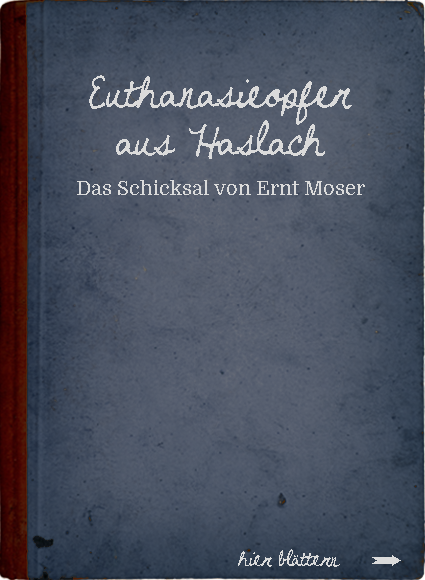
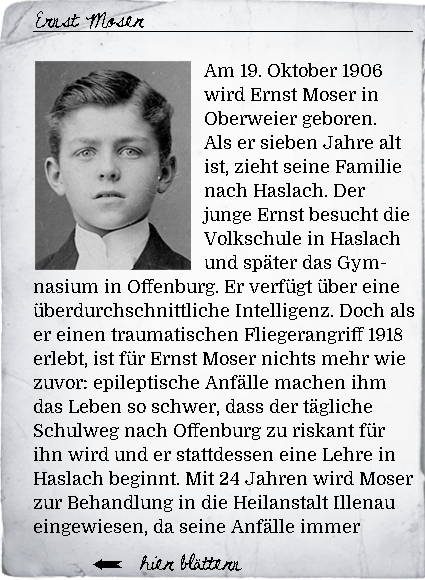
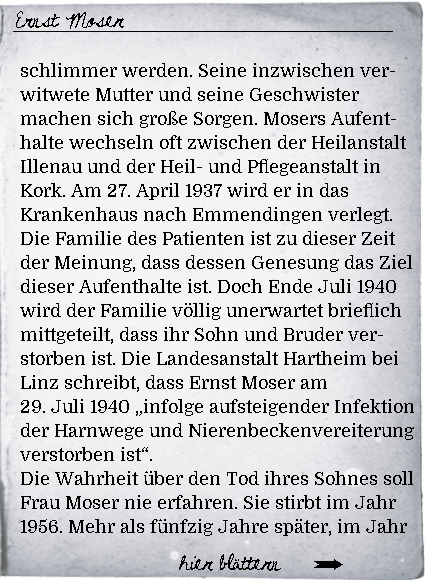
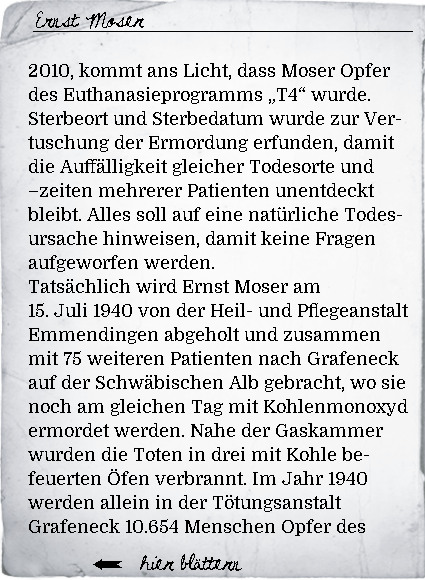
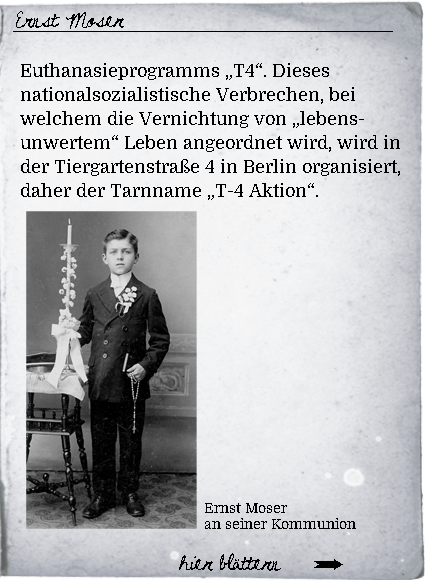
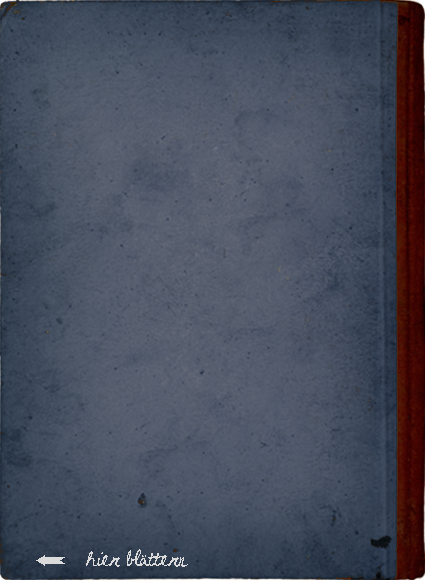
New start
1945 – End of the war
On 8th May 1945 the military victory of the allied forces over Hitler and the Germans is successful, Nazi Germany capitulates. Only now is an end put to the national socialist genocide of the European Jews. Still in early 1945 the last transports take place to the extermination camps. With the end of the war the realisation of a delusional ideology is stopped. And only now do the harrowing dimensions of suppression, exploitation and the unrestricted dictatorial regime’s exercising power come to light. All the persecuted who have survived this period of horror, have to find a new orientation. Their old home does not exist any longer for them.2014 – Jewish life today
[Development of the Jewish communities 1825-2014]
Today the Jewish community holds regular services in its own community centre “Ohel Schalom”. The Jewish celebrations, also many group activities, characterise the social work of the young Jewish community Emmendingen with its 333 members today.
“The catastrophes of the 20th century without doubt reached rock bottom in human history. They were the result of social and political behaviour which initially referred to emancipatory values such “Liberty, equality, fraternity” and had a pronounced civic claim. The “Diversity of the People” was thereby earnestly mentioned as the greatest the development of mankind had brought forward – and nevertheless they failed due to fear of violent utopias of a homogenous society. The protagonists of this fear were the dictators of the century. They wanted to lead the historical development to its terminus, to create a new society with new people, be it at the expense of the extermination of humanity, its culture, its traditions, its belief. This path cannot be understood without taking a glance at the past. It can be understood in anniversaries with the corresponding recollections and in the places with the possible spatial confrontation with suffering, allegation and historical political conflicts. Once again reference is made to the memorials which as a whole illustrate the dimensions of a fundamental breakdown of civilisation.”
Peter Steinbach in "Memorials and political education in Baden-Württemberg"
List of sources
Further literature on the text
Hundsnurscher, F. & Taddey, G. (1968). Die jüdischen Gemeinden in Baden. Denkmale, Geschichte, Schicksale. Stuttgart: W. Kohlhammer Verlag.Kaufmann, Uri R. (2007). Kleine Geschichte der Juden in Baden. Karlsruhe: G. Braun Buchverlag.
Maier, Kurt (2011). Unerwünscht: Kindheits- und Jugenderinnerungen eines jüdischen Kippenheimers. Heidelberg: verlag regionalkultur.
Schellinger, U. (Hrsg.) (2002). Gedächtnis aus Stein. Die Synagoge in Kippenheim 1852- 2002. Heidelberg: verlag regionalkultur.
List of pictures and music according to text sections
Mid-19th century – Building Synagogues: Centre piece of the Jewish communities
The picture of the exterior facade of the former Synagogue in Kippenheim and of the Altar in Kippenheim were provided by the Förderverein Ehemalige Synagoge Kippenheim e. V.Document on One thousand and One nights was provided by the Ehemalige Synagoge e.V. Sulzburg Town.
1847 – Roots of our Democracy: Offenburg Assembly
All the pictures in the video were provided by the Town of Offenburg.Speaker: Fabian Moser
Music: March of the Heavy Engeneers by Bruno Antonio Buike, Licence [CC BY-NC-ND 3.0]
End of the 19th century – Period of tolerance
The pictures 'Die Synagoge in Offenburg' and 'Errichtung der Offenburger Synagoge' were provided by the museum’s archives of the Town of Offenburg.The picture 'Die Synagoge in Emmendingen vor der Renovierung 1922/23' was provided by the Verein für jüdische Geschichte und Kultur Emmendingen e.V.
The picture 'Die Synagoge in Sulzburg' was provided by the Freundeskreis Ehemalige Synagoge e.V. Town of Sulzburg.
1914 – World War I and the end of the empire
The two pictures on World War I were provided by the Initiative Gedenkstätte Vulkan AG of the Historical Association Haslach.1920ies – Failure of the young Weimar Democracy
The source of all pictures in the video on ‚’ is Kurt Maier’s book Unwanted: Kindheits- und Jugenderinnerungen eines jüdischen Kippenheimers/Memories of the childhood and adolescence of a Kippenheim Jew (also refer to further literature on the text).Speaker: Michael Schmidt
Music: Woods of Chaos von Rob Costlow – Contemporary Piano, Licence [CC BY-NC-ND 3.0]
1938 - Demonstrative humiliation of a culture
The Initiative Gedenkstätte Vulkan AG of the Historical Association Haslach provided all the pictures for the video about Joseph Bloch and his family.Speaker: Marcel Hoeser
Music: Nostalgie d'automne von Francine Hauchart, Licence [CC BY-NC-SA 3.0]
Die Breisacher Synagoge brennt provided by Förderverein Ehemaliges Jüdisches Gemeindehaus Breisach e.V.
Gemeindehaus Emmendingen nach der Pogromnacht sowie Die abgebrannte Synagoge in Emmendingen – taken from the brochure “Places, Scenes, Traces. Jewish life in Emmendingen“ from the Verein für jüdische Geschichte und Kultur Emmendingen e.V.
Die verwüstete Synagoge in Kippenheim from Kurt Maier’s book Unerwünscht: Kindheits- und Jugenderinnerungen eines jüdischen Kippenheimers.
Geschändete Thorarolle aus der Offenburger Synagoge provided by the museum’s archives of the Town of Offenburg.
1940 - Deportations in Baden
All the pictures of the slide show Wie Kurt Maier die Deportation erlebte are from Kurt Maier’s book Unwanted: Memories of the childhood and adolescence of a Kippenheim Jew and were provided in digital format by the Förderverein Ehemalige Synagoge Kippenheim e. V.Speaker: Michael Schmidt
Music: Frozen Silence von Meadow, Licence [CC BY-SA 3.0]
The pictures of the video Emma Schwarz berichtet über ihre Deportation, which show the passport photo of Emma Schwarz herself and the business of her deceased husband, are taken from the brochure “Places, Scenes, Traces. Jewish life in Emmendingen” of the Verein für jüdische Geschichte und Kultur Emmendingen e.V.. The Initiative Gedenkstätte Vulkan AG of the Historical Association Haslach may be named as source of the two pictures of Gurs.
Speaker: Judith Aurand
Music: Chopin‘s Song von Etienne Gervot, Licence [CC BY-SA 3.0]
1940-1943 – The Camp in Gurs
All the pictures of the video Kurt Maier erzählt von der Emigration seiner Familie are from Kurt Maier’s book Unwanted: Memories of the childhood and adolescence of a Kippenheim Jew and were provided in digital format by the Förderverein Ehemalige Synagoge Kippenheim e. V.Speaker: Michael Schmidt
Music: Hope you will fine von Stefano Mocini, Licence [CC BY-NC-SA 3.0]
The diary entries and the pictures about Clementine Neu were provided by the museum’s archives of the Town of Offenburg.
1940 to 1945 – Forced labour in the Third Reich
The introductory photograph of forced labourers and all the pictures in the video Eugen Müller über seine Zeit im Lager Vulkan were provided by the Initiative Gedenkstätte Vulkan AG of the Historical Association Haslach.The original recording of Eugen Müller was also provided by the Memorial Initiative.
Music: The Distance von Blukaos, Licence [CC BY-SA 3.0]
All the pictures in the video Die Haslacherin Rosa Jägle erzählt were provided by the Initiative Gedenkstätte Vulkan AG of the Historical Association Haslach.
The original recording of Rosa Jägle was also provided by the Memorial Initiative.
Music: In Time von Jason Pfaff, Licence [CC BY-NC-ND 3.0]


